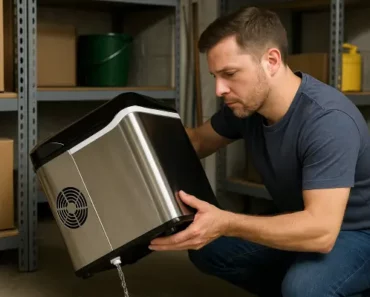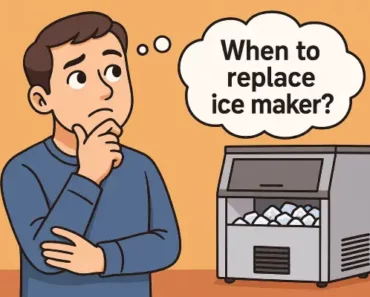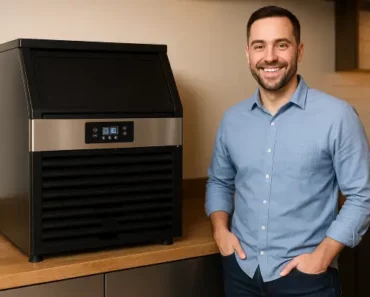Have you ever wondered how do ice machines make ice so fast, producing fresh ice cubes within minutes while your refrigerator takes hours? Even when you understand fully how does an ice maker work, it is still vague to know exactly why the ice machine can make ice so fast. I find it specific enough to make this article just to answer this question.
The rapid ice making process is the main reason why the ice makers are so popular at the moment, especially when global warming is more extreme. Most modern refrigerators do the same technology to produce quick ices, but ice makers still my picks for making many different ice types in the most reliable way.
I’ve made a comprehensive “Ice Maker FAQ” series collecting all common ice maker problems to help Ice Artisan readers quickly troubleshoot their ice maker units.
- ⚖️ Countertop vs undercounter ice makers
- 👍 Are portable ice makers worth it?
- ⚡ How much electricity does an ice maker use?
- 💧 Does an ice maker use a lot of water?
- 🪣 Do ice makers need to be drained?
- 🚫 Can ice makers cause water damage?
- 🚰 Do ice makers need water lines?
- 🔊 Are countertop ice makers loud?
- 😭 Do ice makers make a lot of noise?
- 🔗 Are countertop ice makers safe?
- ⛺ Can ice makers be used outdoors?
- 🔌 Can ice makers be left running all the time?
- 🚗 Can ice makers be used in RV?
- 🗄️ Can ice makers be installed in cabinets?
- ❄️ Do portable ice makers keep ice frozen?
- 🛠️ Can ice makers be used in garages?
- 📄 Do ice makers store ice?
- 🚀 How do ice makers make ice so fast?
- 💡 How does ice maker work?
- 🎰 How does a commercial ice maker work?
- 🛠️ How to install an undercounter ice maker?
- ❄️ How to make clear ice in ice maker?
- 🪣 How to increase ice production in ice maker?
- ⏳ How long does an ice maker take to make ice?
- 🔗 When to replace ice maker filter?
- ⏱️ When to replace ice maker?
- 💡 How to clean ice maker?
- 😭 Why does my ice maker smell bad?
- 🫗 How to drain an ice maker?
- 🪣 How to unclog an ice maker?
- 🔗 How do I unstick my ice maker arm?
- 💧 How to fix ice maker leaking water?
- ❄️ Why is my portable ice maker making too much ice?
- 🥵 Why is my ice maker hot?
- 🔌 What happens if you don’t turn off the ice maker?
- 🧊 How to fix ice maker not making ice?
Ice Artisan‘s best picks
How do ice makers make ice so fast?
Ice makers produce ice so fast by concentrating powerful cooling directly onto small volumes of water through refrigerated metal surfaces, which is better than the insulating air barrier in traditional freezing methods while continuously circulating water to maximize cooling contact.
To simplify my explanation, I will break into 5 factors: concentrated cooling power, direct contact, water motion, ice shapes and harvesting system.

Concentrated cooling power
Ice makers make ice so fast because they concentrate extreme cooling power directly on small water volumes. Unlike freezers that cool entire compartments to -18°C, ice makers use their full refrigeration capacity to specialized evaporators reaching -23°C to -30°C. This intense cooling power accelerates the freezing process significantly. Countertop ice makers can make their first batch of ice in just 6-10 minutes, and even undercounter ice makers need only 15 minutes to produce a bigger first batch of ice.
Direct contact advantage
The speed of ice makers also comes from eliminating the air barrier present in conventional freezing. In freezer trays, an insulating layer of air surrounds the water, slowing heat transfer. Ice makers, however, create direct contact between water and super-cooled metal surfaces, improving thermal conductivity by 300-400%. This direct contact method extracts heat from water nearly instantaneously rather than gradually, explaining why your countertop ice maker can produce multiple batches per hour.
Vertical water motion
Water motion also accelerates freezing time. Ice makers continuously circulate water across their cooling elements, preventing the formation of insulating ice layers that would otherwise slow the process. This constant motion ensures that warmer water doesn’t become trapped in pockets, maintaining maximum temperature differential throughout the freezing cycle. The circulation system moves approximately 0.5-0.7 liters per minute in residential models, resulting in freezing times 2.5-3.0 times faster than static water.
Optimal ice shapes
The distinctive shapes produced by ice makers – bullets, crescents, or nuggets – are specifically designed for quicker ice production. These shapes feature optimized surface-to-volume ratios that freeze 2.8 times faster than solid cubes of equal volume. Nugget ice, for instance, consists of compressed ice flakes that form in just minutes rather than the solid blocks that require significantly longer freezing times.
Optimal harvesting system
Ice makers achieve their impressive quick ice production through remarkably efficient harvest cycles. Once ice forms, the machine quickly releases it (within 30-45 seconds) and immediately begins producing the next batch. This continuous operation means a typical countertop unit can cycle through 9-14 complete freezing cycles per hour. Advanced models employ hot gas bypass systems that instantly release ice without waiting for complete defrosting, reducing non-productive time to just seconds between cycles.
Conclusion
While modern refrigerators use the similar rapid-freezing technology just like ice makers, I still prefer ice makers for ice production. The specialized ice makers concentrate all their cooling power exclusively on ice production, unlike refrigerators that need to divide resources between multiple cooling zones. A standalone ice maker produces up to 3-5 times more ice daily while consuming less energy per ice pound than refrigerator models.
For people that frequently need ice, the convenience of an ice maker proves invaluable. Even when you’re looking to invest in an undercounter ice maker, it would be a great companion for your kitchen, and you don’t need the freezer of your refrigerator to make ice, thus saving more spaces for other purpose. I highly recommend you to read my article “Countertop vs undercounter ice makers“, to see which one is suitable for your needs.





